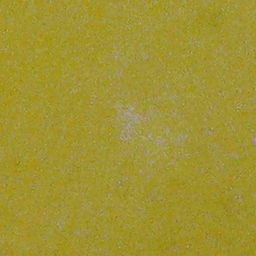(26 January, 2006)
2,5-Diphenyloxazole, commonly known as PPO, is a very efficient laser dye that has its output primarily in the long UV, at and around 365 nm. (I am hoping that I will be able to tune it to the edge of the visible range.) PPO is fairly easily pumped by nitrogen lasers. We recently acquired a small amount of scintillation-grade PPO on eBay. (Unfortunately the vendor from whom we purchased it appears to be gone as of Autumn, 2007.)
This material has not been purified to laser-grade standards, but as you can see, that doesn’t prevent it from lasing. We probably aren’t getting as much power from it as we might, and the tuning range is almost certainly narrower than the literature would suggest, but the price and availability more than make up for those shortcomings.
PPO is relatively nonpolar. Unlike the usual visible laser dyes, most of which dissolve nicely in alcohols and other polar solvents, even water, PPO dissolves most easily in hydrocarbons. Because I don’t happen to have any petroleum ether or cyclohexane on hand, and because many Do-It-Yourselfers no longer have access to formal chemicals, I decided to try it in commercial heater fuel (also loosely called “lamp oil”), which I purchased at a local hardware store. First I made sure that the fuel itself was colorless and transparent, and did not fluoresce, at least in the visible range. Then I filled one of our fused silica cuvettes with it, saturated it with PPO, allowed the excess PPO crystals to settle to the bottom, and focused the output of one of a nitrogen laser into it.
[Note, added 26 December, 2010: see the added section
at the end of this page.]
First, here’s a quick look at the dye laser. This is an extremely informal setup. The UV pulse from the Molectron nitrogen laser (which is visible at the left side) is focused into the front face of a dye cuvette, using the concave mirror that is visible at the upper right. There is one mirror, which I have loosely aligned with the cuvette. I made no attempt to tune the output, as this was simply a feasibility test. The first photo shows the setup with the Molectron turned off; the second with it on and pulsing several times a second. (It is a commercial low-pressure N2 laser that puts out pulses about 6 nsec long, FWHM.)
The next two photos show the output from the dye, first hitting some paper (which is brightly fluorescent) and then a ceramic tile (which is not very fluorescent).
You will notice a purple arrow on the photo of the tile. About half an arrow-length to the left of the point, there is a barely-visible glowing spot. This is either the fluorescence of the tile, or the UV response of the sensor in the camera. (More likely the tile fluorescence, as it was visible to the eye.)
Here is just the region of the spot, with the contrast turned up to make it easier to see. (Unfortunately, I do not have a larger version of this image; it is a direct crop from the original.)

Here, finally, is one pulse of the dye output on our Tektronix 7104 oscilloscope (Motorola MRD500 photodiode driving a Tek 7A29 vertical amplifier):
(My apologies for the fact that this is wretchedly fuzzy; the camera was not on a stable surface, and the battery crapped out on me before I could get a better shot.)
You can see that the dye pulse is only a little over 2
nsec long FWHM, and that it has a “tail”;
the tail appears to be characteristic of this kind of
setup; so far, at least, it has not been present when I
have eliminated the mirror.
(26 December, 2010)
As part of another project, I recently brought our PRA LN 1000 room-pressure nitrogen laser back online, and this evening I used it to pump a cuvette of PPO, which I dissolved in 99.85% isopropanol this time. It worked quite well:
(I think that’s a single pulse from the LN 1000, but I can’t really prove it.)
I tried to find out whether the camera could detect the beam, but I don’t have a nonfluorescent “white” tarket yet, so I used something dark, which didn’t make things any easier. There is a spot, about in the middle of the mauve circle, but it isn’t very bright...
(As far as I can tell, that was three pulses from the LN 1000.)
I have not attempted to ’scope the output of this
rig yet, so I can’t say for certain how long the
pulse is, but it should be somewhat less than 1 nsec.
Scintillation-grade PPO has been shown to lase when pumped with nitrogen laser pulses of modest power, when dissolved in commercial heater fuel or in 99+% isopropanol. A decrease in output with time was observed in the heater fuel solution, and it is possible that PPO is inherently unstable in this solvent, or that some photochemistry is occurring, or simply that the solvent has large change of refractive index with temperature. [I do not know how stable PPO is in other solvents.]
Note: This is the first time I have ever lased a
dye in the ultraviolet, and it may be the first time
anyone has ever lased a dye in lamp oil; I certainly
haven’t ever heard of anyone trying that.
Another nitrogen-pumped dye laser page, dealing with a setup that is tuned with a prism (I have also used a grating, and I think I prefer it)
A page about 4-Methyl-Umbelliferone, a dye that has an extremely broad tuning range
A Do-It-Yourselfer’s nitrogen laser
Email: a@b.com, where my first name (just three letters, no “H”) replaces the a, and “joss” replaces the b.
My phone number is +1 240 604 4495.
Last modified: Thu Jun 23 15:42:04 CDT 2016